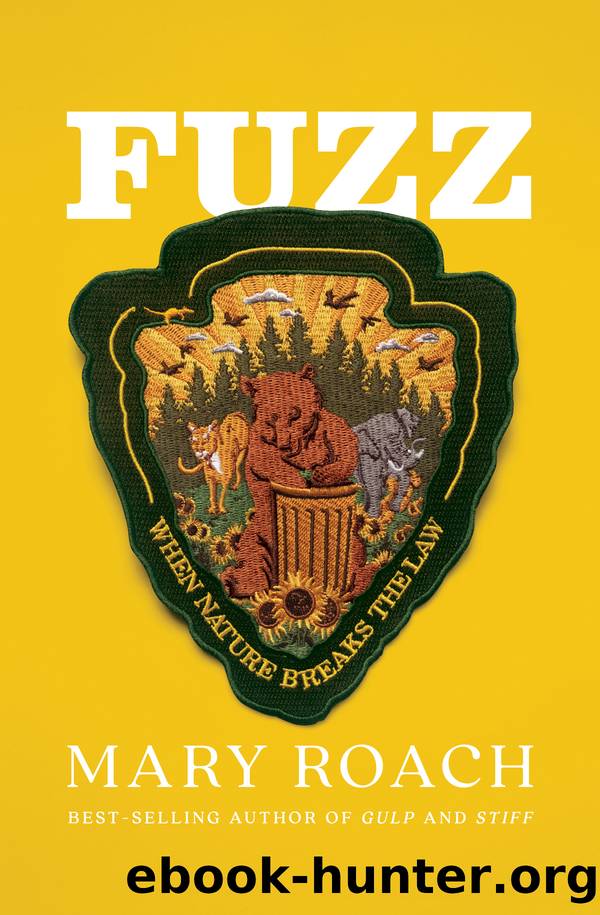Fuzz: When Nature Breaks the Law by Mary Roach

Author:Mary Roach [Roach, Mary]
Language: eng
Format: epub
Tags: science, Philosophy & Social Aspects, nature, animals, Wildlife, Animal Rights, Life Sciences, Zoology, Ethology (Animal Behavior)
ISBN: 9781324001843
Google: 7JAgEAAAQBAJ
Publisher: W. W. Norton & Company
Published: 2021-09-14T00:00:39.860523+00:00
Warfare and pest control long strolled hand in hand. Both, after all, seek to destroy grouped adversaries as efficiently as possible. Up until the nuclear era, any newfangled deadliness trained upon human enemies also tended to be tried out on enemies of the furred and feathered variety. A United Nations summary of control efforts used on the African quelea (or âlocust birdâ), for example, reads like a timeline of military weaponry: âguns, explosives, flame throwers, jellied gasoline, and contact poisons.â
During World War II, the chemical warfare people and the agripest control people were united by a common foe: the brown rat. Aka the Norway rat, aka the sewer rat, akaâquoting a Denver Wildlife Research Laboratory press releaseââHitlerâs ace agent in this country.â Supply routes for the raw materials for existing rat poisons had been cut off during the war, and rats were living high: â⦠sabotaging factories, destroying food needed for our allies, and spreading disease among our armed forces.â This was not the first time rodents had been portrayed as enemy sympathizers. Posters for a California ground squirrel eradication campaign during World War I featured squirrels in tiny spiked German helmets. âMrs. Squirrelâ has been decorated with the Iron Cross, one of the highest military honors of the German Empire, which she wears as a necklace.
In June 1942, an unusual wartime alliance was forged. Division 9 (chemical weapons) of the National Defense Research Committee (NDRC) of the U.S. Office of Scientific Research and Development joined forces with the Denver Wildlife Research Laboratory (now the NWRC) in a quest for new rat poisons. The former suggested promising toxins from the arsenal, and the latter tried them out on traitorous vertebrates. Ricin, under the code name âcompound W,ⶠwas a candidate, as was sarin. The standout rodenticide, first tested in June 1944, was a phytotoxin the Division 9 people referred to as 1080. It was cheap and quickly lethal to rats.
Long before the ministries of war and agriculture got wind of it, 1080 had been used in rural Africa, in its natural plant form. Then, too, both rodents and humans were potential targets. Because the toxin imparts almost no detectable taste, the aggressor would simply crush the plant and drop it down the enemyâs well. While I might question the efficacy of the raw plant material, the lethality of the toxin eventually isolatedâa fluoroacetate given the code name TWSâis well documented.
TWS was accidently discovered by a team of Polish chemists who later shared it with Allied intelligence. According to a declassified Division 9 memo dated April 20, 1945, a related fluoroacetate was under consideration as a âcontaminant for water suppliesâ but never used. Personnel quoted in the memo had been shown footage of poisoned dogs and deemed it âan extremely revolting spectacle.â (1080 is 17 to 35 times more deadly to dogs than it is to rats.) Both felt strongly that an agent causing death in this âhorribleâ manner âcould not possibly be used by any civilized nation against an enemy even of the most highly depraved type.
Download
This site does not store any files on its server. We only index and link to content provided by other sites. Please contact the content providers to delete copyright contents if any and email us, we'll remove relevant links or contents immediately.
Kathy Andrews Collection by Kathy Andrews(10575)
The remains of the day by Kazuo Ishiguro(7590)
Spare by Prince Harry The Duke of Sussex(4238)
Paper Towns by Green John(4186)
The Body: A Guide for Occupants by Bill Bryson(3847)
Be in a Treehouse by Pete Nelson(3244)
Harry Potter and the Goblet Of Fire by J.K. Rowling(3109)
Goodbye Paradise(2991)
Never by Ken Follett(2925)
Into Thin Air by Jon Krakauer(2721)
The Remains of the Day by Kazuo Ishiguro(2633)
The Genius of Japanese Carpentry by Azby Brown(2622)
The Cellar by Natasha Preston(2614)
Drawing Shortcuts: Developing Quick Drawing Skills Using Today's Technology by Leggitt Jim(2540)
120 Days of Sodom by Marquis de Sade(2454)
Architecture 101 by Nicole Bridge(2360)
Machine Learning at Scale with H2O by Gregory Keys | David Whiting(2337)
The Man Who Died Twice by Richard Osman(2319)
Industrial Automation from Scratch: A hands-on guide to using sensors, actuators, PLCs, HMIs, and SCADA to automate industrial processes by Olushola Akande(2202)
